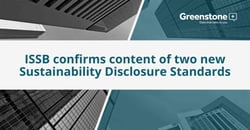ISSB confirms content of two new Sustainability Disclosure Standards
 The International Sustainability Standards Board (ISSB) met in Montreal recently and announced its final decision on the technical content of its initial two IFRS Sustainability Disclosure Standards. The ISSB’s Standards will now go through a thorough drafting and formal ‘balloting’ approval process, ahead of their issuance towards the end of Q2 2023.
The International Sustainability Standards Board (ISSB) met in Montreal recently and announced its final decision on the technical content of its initial two IFRS Sustainability Disclosure Standards. The ISSB’s Standards will now go through a thorough drafting and formal ‘balloting’ approval process, ahead of their issuance towards the end of Q2 2023.
Established at COP26 in late 2021, the ISSB has developed a comprehensive global baseline of sustainability disclosures for the capital markets; one sets out general sustainability-related disclosure requirements and the other specifies climate-related disclosure requirements.
Summary of the initial two IFRS Sustainability Disclosure Standards
The ISSB’s initial two standards focus on general sustainability disclosure requirements (IFRS S1) and climate (IFRS S2). Proposals of these standards were released in March 2022, after which the ISSB received 1,400+ comment letters, that the ISSB considered in its 2022 and 2023 board meetings.
S1 asks for disclosure of material information about a company’s sustainability-related risks and opportunities. It uses the same definition of material that is used in IFRS Accounting Standards – that is, companies must determine that information is material i.e. that which if absent, obscured, or misstated could be reasonably expected to influence investor decisions.
S1 emphasises the need for consistency and connections between financial statements and sustainability disclosures, requiring financial statements and sustainability disclosures to be published at the same time. (The ISSB has introduced a transitional relief to allow later reporting of the sustainability information aligned with the first half results for a short period of time.)
S2 sets out disclosure of material information about climate-related risks and opportunities, including disclosure about physical risks (such as flood risk), transition risk (such as regulatory change) and climate-related opportunities (such as new technologies).
As part of its work to support adoption and high-quality disclosures, the ISSB has developed a package of reliefs and guidance to support initial use of the Standards, enabling companies at all stages of sustainability disclosure to scale up their approach to using them over time.
Role of pre-existing standards and frameworks
As part of its work to consolidate a fragmented disclosure landscape and provide a clear pathway for current sustainability reporters, the ISSB is building off existing and widely used standards and frameworks. Here’s how these are being used in the ISSB’s work:
The SASB Standards are used by over 2,500 companies worldwide. They are made up of 77 industry-based disclosure standards developed to provide decision-useful information to investors.
- Using the SASB Standards now will help in the future application of IFRS Sustainability Disclosure Standards.
- As described in S1, industry-specific disclosures are required by those applying the ISSB’s Standards, and companies need to consider the existing SASB Standards to identify topics and metrics to disclose in the absence of a specific ISSB Standard.
- This means the SASB Standards will continue to be supported on a standalone basis by the ISSB for at least four years, and realistically probably longer, while the ISSB continues its standard-setting activities using the SASB Standards as a basis.
- The ISSB has introduced rigorous due diligence process to ensure the SASB Standards are maintained and enhanced over this time with any proposed changes being subject to public consultation.
- The climate-related aspects of the SASB Standards are now illustrative guidance that a company needs to consider, but is not required to use when using S2.
- More information on the future of the SASB Standards.
The TCFD Recommendations have over 4,000 supporters worldwide and were designed to solicit decision-useful, forward-looking information that can be included in mainstream financial filings.
- The core structure of the IFRS Sustainability Disclosure Standards is adopted from the TCFD architecture to solicit information on governance, strategy, risk management and metrics and targets. S1 and S2 fully incorporate the TCFD Recommendations, and so those disclosing against S1 and S2 will meet the TCFD Recommendations.
The CDSB Framework has been incorporated into S1 and S2, and CDSB application guidance on biodiversity-related and water-related disclosures are sources of guidance a company can consider in its disclosures to investors in the absence of a specific ISSB Standard.
The Integrated Reporting Framework is a principles-based, multi-capital framework used by over 2,500 companies in more than 75 countries to communicate how a company creates, preserves and erodes value over time for itself and its investors.
- The Integrated Reporting Framework’s concepts are reflected in S1 to describe the relationship between sustainability and financial value creation.
- Continued use of the Integrated Reporting Framework is encouraged to support high-quality corporate reporting and to drive connectivity between financial statements and sustainability-related financial disclosures.
For more information on these upcoming ISSB standards, click here.









